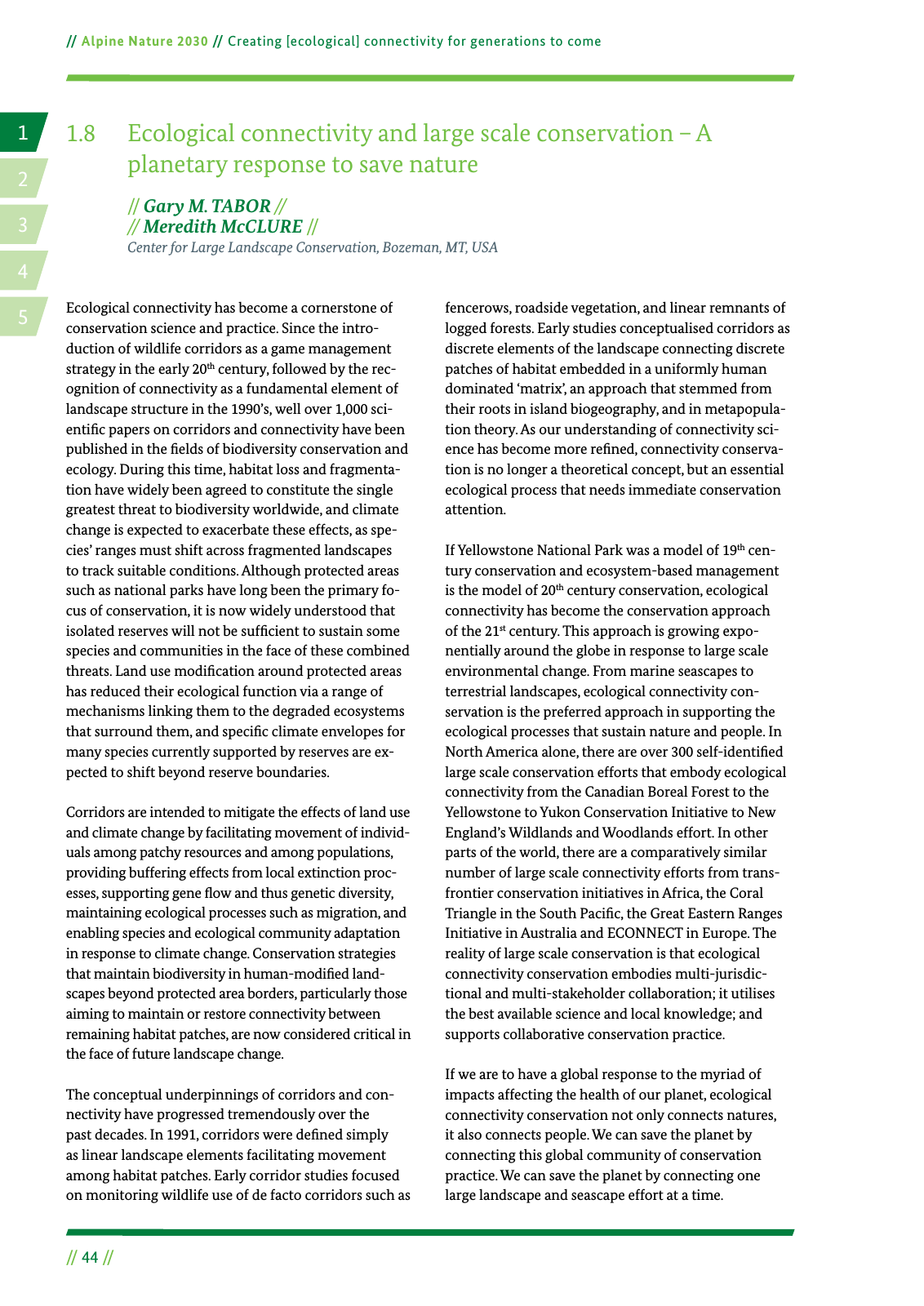14 2 5 3 44 Alpine Nature 2030 Creating ecological connectivity for generations to come Ecological connectivity has become a cornerstone of conservation science and practice Since the intro duction of wildlife corridors as a game management strategy in the early 20th century followed by the rec ognition of connectivity as a fundamental element of landscape structure in the 1990 s well over 1 000 sci enti c papers on corridors and connectivity have been published in the elds of biodiversity conservation and ecology During this time habitat loss and fragmenta tion have widely been agreed to constitute the single greatest threat to biodiversity worldwide and climate change is expected to exacerbate these effects as spe cies ranges must shift across fragmented landscapes to track suitable conditions Although protected areas such as national parks have long been the primary fo cus of conservation it is now widely understood that isolated reserves will not be suf cient to sustain some species and communities in the face of these combined threats Land use modi cation around protected areas has reduced their ecological function via a range of mechanisms linking them to the degraded ecosystems that surround them and speci c climate envelopes for many species currently supported by reserves are ex pected to shift beyond reserve boundaries Corridors are intended to mitigate the effects of land use and climate change by facilitating movement of individ uals among patchy resources and among populations providing buffering effects from local extinction proc esses supporting gene ow and thus genetic diversity maintaining ecological processes such as migration and enabling species and ecological community adaptation in response to climate change Conservation strategies that maintain biodiversity in human modi ed land scapes beyond protected area borders particularly those aiming to maintain or restore connectivity between remaining habitat patches are now considered critical in the face of future landscape change The conceptual underpinnings of corridors and con nectivity have progressed tremendously over the past decades In 1991 corridors were de ned simply as linear landscape elements facilitating movement among habitat patches Early corridor studies focused on monitoring wildlife use of de facto corridors such as 1 8 Ecological connectivity and large scale conservation A planetary response to save nature Gary M TABOR Meredith McCLURE Center for Large Landscape Conservation Bozeman MT USA fencerows roadside vegetation and linear remnants of logged forests Early studies conceptualised corridors as discrete elements of the landscape connecting discrete patches of habitat embedded in a uniformly human dominated matrix an approach that stemmed from their roots in island biogeography and in metapopula tion theory As our understanding of connectivity sci ence has become more re ned connectivity conserva tion is no longer a theoretical concept but an essential ecological process that needs immediate conservation attention If Yellowstone National Park was a model of 19th cen tury conservation and ecosystem based management is the model of 20th century conservation ecological connectivity has become the conservation approach of the 21st century This approach is growing expo nentially around the globe in response to large scale environmental change From marine seascapes to terrestrial landscapes ecological connectivity con servation is the preferred approach in supporting the ecological processes that sustain nature and people In North America alone there are over 300 self identi ed large scale conservation efforts that embody ecological connectivity from the Canadian Boreal Forest to the Yellowstone to Yukon Conservation Initiative to New England s Wildlands and Woodlands effort In other parts of the world there are a comparatively similar number of large scale connectivity efforts from trans frontier conservation initiatives in Africa the Coral Triangle in the South Paci c the Great Eastern Ranges Initiative in Australia and ECONNECT in Europe The reality of large scale conservation is that ecological connectivity conservation embodies multi jurisdic tional and multi stakeholder collaboration it utilises the best available science and local knowledge and supports collaborative conservation practice If we are to have a global response to the myriad of impacts affecting the health of our planet ecological connectivity conservation not only connects natures it also connects people We can save the planet by connecting this global community of conservation practice We can save the planet by connecting one large landscape and seascape effort at a time

Hinweis: Dies ist eine maschinenlesbare No-Flash Ansicht.
Klicken Sie hier um zur Online-Version zu gelangen.
Klicken Sie hier um zur Online-Version zu gelangen.